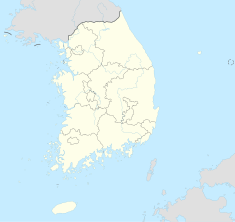Royal Tombs of the Joseon Dynasty
| Royal Tombs of the Joseon Dynasty | |
|---|---|

Yeongneung
|
|
| Location | Gyeonggi-do and Seoul, South Korea |
| Coordinates | 37°33′02″N 127°00′35″E / 37.55056°N 127.00972°ECoordinates: 37°33′02″N 127°00′35″E / 37.55056°N 127.00972°E |
| Built | Joseon Dynasty |
| Governing body | Cultural Heritage Administration of Korea |
| Type | Cultural |
| Criteria | iii, iv, vi |
| Designated | 2009 (33rd session) |
| Reference no. | 1319 |
| State Party |
|
| Region | Asia and Australasia |
|
Joseon Tombs in South Korea
|
|
| Royal Tombs of the Joseon Dynasty | |
| Hangul | |
|---|---|
| Hanja | |
| Revised Romanization | Joseon wangneung |
| McCune–Reischauer | Chosŏn wangnŭng |
The Tombs of the Joseon Dynasty refers to the 40 tombs of members of the Korean Joseon Dynasty (1392–1910). These tombs are scattered in over 18 locations across South Korea. They were built to honor and respect the ancestors and their achievements, and assert their royal authority. The tombs have been registered as a UNESCO World Heritage site since 2009.
The royal tombs can be divided into three main parts:
It is the meeting point between the dead and the living.The area around Hongsalmun gate is the space for the living.
This is the space between the earthly and the holy. This is the area where the spirits of the kings and queens meet their earthly worshippers. This area also contains the Jeongjagak shrine, the Subokbang, and the Suragan buildings.
This area also includes the wall, and the other stone structures.
Other structures include:
The tombs are classified into two types. Tombs of the kings and queens and those posthumously granted the title of king or queen, were interred in neung-type tombs. Crown princes and their wives, as well as the parents of royalty, were interred in won-type tombs. The royal tombs are scattered over 18 locations, with many of them located 40 kilometers from Hanseong (present-day Seoul). Indeed, the Jangneung tomb is in Yeongwol, Gangwon-do, while the Yeongneung tombs are in Yeoju, Gyeonggi-do. Tombs were made for individuals as well as family groups. There are 40 neung-type and 13 won-type tombs, thus creating a total of 53 royal tombs.
Joseon-era royal tombs followed the guidelines outlined in Chinese Confucian texts, such as the Book of Rites (Li Ji) and the Rites of Zhou (Zhou Li). Many factors went into consideration when deciding the location of a tomb, such as the distance from Hanyang, the distance in relation to other royal tombs, the accessibility of the location, and Korean traditions of pungsu (geomancy). The tomb construction also took into account traditional burial rituals of Korea and the natural environment.
...
Wikipedia

